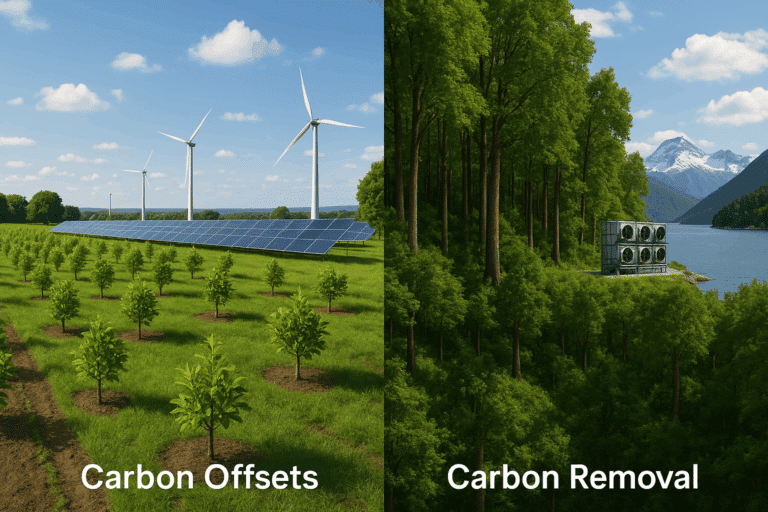🌍 A world where businesses contribute to a sustainable future and make profits simultaneously. Is it a far-fetched idea? Not with the power of carbon pricing and internal carbon fees.
Carbon pricing, an economic strategy, works by putting a cost on each tonne of greenhouse gas emitted. This cost encourages businesses to decrease their carbon emissions, helping the world inch closer to a more sustainable future. Simultaneously, internal carbon fees, when adopted by corporations, create a self-sufficient system that drives environmental change from within. 💼
Before diving into the nitty-gritty of these concepts, it’s essential to understand the basis of the issue at hand – the environmental impact of carbon emissions. Global warming, a rise in average global temperatures, is largely attributed to increasing levels of carbon dioxide and other greenhouse gases. These gases trap heat in the atmosphere, resulting in a ‘greenhouse effect.’ Although naturally occurring, human activities, particularly the burning of fossil fuels, have significantly increased these emissions. 🏭
So, how do we tackle this multifaceted issue? Enter carbon pricing and internal carbon fees – potent tools to drive environmental change. However, they are not without their complexities and challenges. This article aims to elucidate these concepts, exploring their potential and limitations in the quest for environmental sustainability. 🌱
We’ll delve into the intricacies of carbon pricing, discussing how it operates and its potential implications. Next, we’ll look at the concept of internal carbon fees, showcasing how businesses can use this tool to encourage sustainable practices internally. We’ll also consider potential criticisms and pitfalls, offering a balanced view of these strategies. 🔍
Despite the seriousness of the topic, this is not a doom-and-gloom narrative. Instead, it’s a call to leverage economic tools for environmental good. It’s a call to turn the tide on climate change, armed with the power of carbon pricing and internal carbon fees. 🌊
Whether you’re a sustainability enthusiast, a policy maker, a business executive, or simply a curious mind, this exploration will provide valuable insights. So let’s dive into the dynamic world of carbon pricing and internal carbon fees. It’s time to unlock the potential of these economic tools in driving significant environmental change. 💡
As we navigate these topics, remember this isn’t merely an academic discussion. It’s a conversation about the future of our planet. The decisions we make today, the strategies we employ, will shape the world for generations to come. 🌿
Let’s get started. The future awaits.
Decoding Carbon Pricing: An Innovative Tool for Sustainable Change
In today’s world where climate change looms as an impending threat, industries worldwide are transitioning to greener alternatives in a bid to minimize their carbon footprint. One such revolutionary concept is Carbon Pricing. Carbon Pricing is an economic instrument used to charge organizations that emit carbon dioxide (CO2) into the atmosphere. This cost provides a financial disincentive to carbon pollution, encouraging polluters to reduce the amount of greenhouse gas (GHG) they emit into the atmosphere, and driving technological innovation and generation of low carbon and more energy-efficient solutions. In essence, it’s a way of ‘internalizing’ the external cost of carbon pollution, thus making the market prices of goods and services reflect their full production cost.
As a tool for driving environmental change, Carbon Pricing is gaining momentum worldwide, with more and more countries implementing carbon pricing initiatives to meet their sustainability commitments under the Paris Agreement. This agreement, signed by 195 nations in 2015, aims to limit the increase in global average temperature to well below 2 degrees Celsius above pre-industrial levels. Carbon pricing plays a vital role in this context, providing a cost-effective way for nations to reduce their GHG emissions.
There are two main types of Carbon Pricing: Emissions Trading Systems (ETS) and Carbon Taxes. An ETS – also referred to as a cap-and-trade system – caps the total level of GHG emissions and allows industries with low emissions to sell their extra allowances to larger emitters. By creating supply and demand for emissions allowances, an ETS establishes a market price for GHG emissions. On the other hand, a Carbon Tax directly sets a price on carbon by defining a tax rate on GHG emissions or – more commonly – on the carbon content of fossil fuels. It’s generally easier to administer than an ETS, but the environmental effectiveness of a carbon tax depends on its design specifics.
Understanding Internal Carbon Fees: An Inside-out Approach to Sustainability
Moving beyond the realm of governmental intervention, many progressive companies are adopting an inside-out approach to sustainability by levying an Internal Carbon Fee. An Internal Carbon Fee is a self-imposed cost that a company places on each tonne of CO2 it emits. It’s a bold move towards making environmental responsibility an integral part of the business model, instead of an add-on.
Microsoft, for instance, has been charging its business units an internal carbon fee since 2012. The fee is based on the market price of renewable energy and carbon offsets, which the company buys to reach its carbon neutrality goals. Not only does this strategy drive energy efficiency and green innovation within the company, but it also generates funds for Microsoft’s sustainability projects worldwide.
Implementing an Internal Carbon Fee, however, is not as straightforward as it sounds. It requires meticulous planning, proper communication, and most importantly, a shift in the company culture. For it to be successful, all stakeholders, including employees, investors, and customers, need to understand and support the company’s environmental commitment. If implemented well, an Internal Carbon Fee can serve as a strategic tool for companies to not only reduce their carbon footprint but also drive innovation, increase competitiveness, and enhance their reputation.
Comparative Impact: Carbon Pricing vs. Internal Carbon Fees
The following table provides a comparative overview of Carbon Pricing and Internal Carbon Fees, highlighting their key features, advantages, and potential challenges.
| Carbon Pricing | Internal Carbon Fees | |
|---|---|---|
| Key Features | Government-imposed cost on carbon pollution. Includes Emissions Trading Systems (ETS) and Carbon Taxes. | Company-imposed cost on carbon emissions. Based on the market price of renewable energy and carbon offsets. |
| Advantages | Cost-effective way for nations to reduce their GHG emissions. Encourages green innovation and energy efficiency. | Drives internal energy efficiency and green innovation. Generates funds for the company’s sustainability projects. Enhances company’s reputation. |
| Potential Challenges | Requires global cooperation and policy alignment. Effectiveness depends on design specifics. | Requires shift in company culture. All stakeholders need to support the company’s environmental commitment. |
For a comprehensive understanding of how carbon pricing works, watch the video ‘Carbon Pricing: A Practical Business Guide’ by the World Bank (via their YouTube channel).
Maximizing Sustainability: The Role of Businesses and Governments
While both Carbon Pricing and Internal Carbon Fees offer effective ways to combat climate change, their success greatly depends on the commitment of businesses and governments alike. Governments play a crucial role in establishing robust carbon pricing mechanisms and providing a supportive regulatory framework. They need to set ambitious but achievable emission reduction targets, ensuring transparency and accountability in their climate actions.
Businesses, on the other hand, have a unique opportunity to lead the sustainability transition. By adopting measures like Internal Carbon Fees, they can turn carbon reduction into a strategic business opportunity. However, this requires a shift from a short-term profit mentality to a long-term sustainability vision. It’s about recognizing that in the long run, the costs of not acting on climate change far outweigh the costs of reducing carbon emissions today.
Ultimately, maximizing sustainability is a shared responsibility. It requires collective action and innovation at all levels – from individuals and businesses to governments and international organizations. Only then can we hope to limit global warming and create a sustainable future for all.

Conclusion
Throughout this comprehensive article, we have delved into the intricate details of the world of Information Technology and Engineering, particularly focusing on the importance of software engineering in today’s increasingly digital landscape.
We have journeyed together through the compelling intricacies of software development, understanding its role in transforming ideas into functioning software products. The importance of each stage of the software development lifecycle, from planning to deployment, was underscored, emphasizing how each phase is crucial in shaping the overall quality of the final product.
We also walked through the diverse range of programming languages, their syntax, and their real-world applications. This exploration was designed to highlight the versatility and power of these tools in creating robust software solutions. The importance of choosing the right programming language for your project cannot be overstated, and hopefully, our in-depth comparison has given you a clearer direction.
Furthermore, the indispensable role of testing in software development was explored, where we talked about different types of testing methods like unit testing, integration testing, and system testing. This segment helped to underline the essential nature of rigorous testing procedures in delivering bug-free, efficient software.
Lastly, we examined the world of cloud computing, discussing its influence on modern businesses and individuals alike. We talked about the benefits and potential drawbacks of cloud computing, thereby highlighting the critical need for informed decision-making when it comes to utilizing these services.
In conclusion, the world of software engineering is vast and complex, but it is also immensely rewarding and exciting. The possibilities it presents for businesses, individuals, and society at large are virtually endless. I hope this article has ignited your curiosity and encouraged you to explore more about this fascinating field.
Remember that learning is a continuous process, so don’t hesitate to dig deeper into any of the topics we’ve discussed today. There are plenty of online resources available, and I recommend visiting the official websites for different programming languages, testing methodologies, and cloud service providers for more information.
I encourage you to share this article with colleagues, friends, or anyone who might find it beneficial. Your sharing of knowledge can make a significant difference in someone else’s learning journey. And, as always, feel free to leave your comments, thoughts, or queries in the comment section below. I would be more than happy to engage in a conversation with you.
Thank you for taking the time to read through this article. I hope that it has provided valuable insights and sparked your interest in the field of software engineering. Remember that the world of technology is constantly evolving, and there’s always something new to learn. So, keep exploring, keep learning, and keep pushing the boundaries of what’s possible! 😊👍💻



